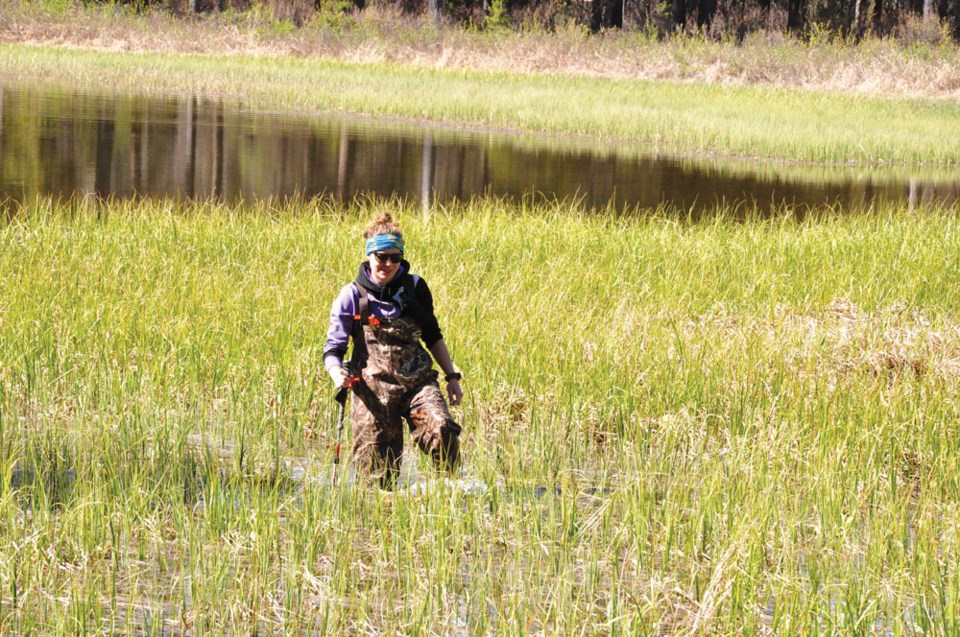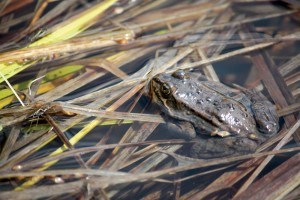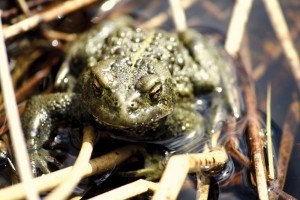
Each spring, amphibian lifecycles begin in ponds throughout Jasper National Park.
Eggs are laid in varying configurations, tadpoles are hatched and baby frogs, toads and salamanders are formed.
To track the health of the park’s amphibian populations, Parks Canada’s Aquatic Specialist, Ward Hughson, visits 62 randomly selected ponds every three years as part of a long-term amphibian survey.
The survey is a huge undertaking; over the course of two and a half weeks, each of the ponds is surveyed three times, for a total of 186 site visits.
Obviously, that’s a job far too big for one man. So, to help him each survey year, Hughson recruits more than a dozen dedicated volunteers, all of whom are trained to differentiate between each of the park’s amphibian species, as well as their eggs and tadpoles.
On a site visit, Hughson and his volunteers each wear army green waders to protect them from the knee-deep mud they’ll inevitably sink into while trudging around each pond’s perimeter. Fortunately, as well as the waders, each surveyor is also equipped with a hiking pole—a tool that will be praised time and time again as it provides the necessary leverage to get of sticky situations.
The get-up is completed with polarized sunglasses, a clipboard, pencil, ruler, camera and two thermometers—one for air temperature and another for water temperature.
With all the gear dangling from every possible pocket, trudging becomes ever-so-slightly more precarious—at least until you figure out the perfect filing system: the camera tucked in an easily accessible pocket, the clipboard tucked under an armpit, with the ruler and pencil secured under the clamp and the sunglasses firmly planted on the bridge of your nose.
By that time, the thermometers are in place, one hanging in the shade and the other in the water, marking the survey’s starting point.

JNP is home to wood frogs, Columbian spotted frogs, western toad and long-toed salamander, all of which breed in water during the spring.
“So that’s our opportunity to see what’s happening at each of the sites,” said Hughson, noting he and his volunteers monitor the occupancy of each of the ponds. That means looking to see what species are present at each site overtime and recording whether that presence is staying the same, increasing or declining.
“Really the question is, what’s the health of the park?”
To make that determination, the survey looks at what species are present in each pond, as well as where each specimen was located at the time of the survey.
While tromping around—careful not to step on anything precious—surveyors eyes are on the water’s edge, looking for eggs, tadpoles, young amphibians and adults. When they find one of the above, they take a photo of it alongside their trusty ruler and mark the location on a map, with an abbreviated tag denoting what they found.
Hughson said the photos provide a failsafe; in the case that the surveyor misidentifies what they found, he can correct it later, just by looking at the photo.

For a quick study, differentiating between each of the species is something that can be learned within a couple of hours.
Here’s the Cole’s Notes version.
Wood frogs often have white stripes down their backs, although not always. Whereas, western toads always have a white stripe, but they are also larger in size and covered in bumps—Hughson is hesitant to call them warts.
Spotted frogs—you guessed it—have spots. And salamanders, well, they’re a completely different beast, making them impossible to misidentify.
Although seemingly simple, Hughson said it’s actually quite rare that surveyors will see adults—instead they’ll see eggs.
“So knowing how to tell the difference between the egg masses is a prime objective when I’m teaching people.”
Hughson uses a fruit analogy to explain the differences—although he’s likely to stray off course and throw in a golfball every once in awhile. But, sticking with fruit, he begins with “a very small fruit, not a cherry.”

For arguments sake, we’ll call it an apricot.
A wood frog’s freshly laid egg mass is the size of an apricot and is found in a large grouping, with dozens of other masses from 85 to 90 per cent of the breeding females in the pond.
Overtime each mass will expand until the tadpoles are formed. That expansion happens when the gelatinous mass surrounding each egg absorbs water.
So, a wood frog’s egg mass will go from the size of an apricot to the size of a medium orange, while a spotted frog’s egg mass will go from the size of a medium orange to the size of a cantaloupe.
Toad eggs, on the other hand, aren’t laid in a mass at all. Rather, two strings of eggs will come from a toad and be laid all over the pond, creating a maze of eggs that looks a bit like a child’s pencil drawing.
Salamanders lay their eggs on a piece of vegetation, winding up from the bottom.
With wood frogs and spotted frogs, each mass equates to one female, so the masses are counted. But with toad and salamander eggs there is no way to tell whether a string of eggs is one toad or one salamander or if it belongs to numerous.
This was the fourth survey year.
With a long-term project like this, Hughson said you don’t expect to see huge fluctuations from one survey year to the next—and such fluctuations haven’t formulated in Jasper.
But, what the survey has done is taught the park’s biologists about amphibian habitat.
“One of the biggest discoveries that we’ve made—which is proven here as well as in other areas where amphibians are studied—is that one of the biggest deterrents to amphibian occupancy is the presence of fish.”
Hughson said that this finding is especially interesting because historically, Parks Canada used to stock the park’s water bodies with various species of fish.
“Fish were put into many, many water bodies, with probable impacts to amphibian populations, specifically to salamanders. They seem particularly susceptible.”
The next survey will take place in 2018.
Hughson encourages anyone with an interest in amphibians to get in touch at that time—he could certainly use the extra hands.
Nicole Veerman
[email protected]
